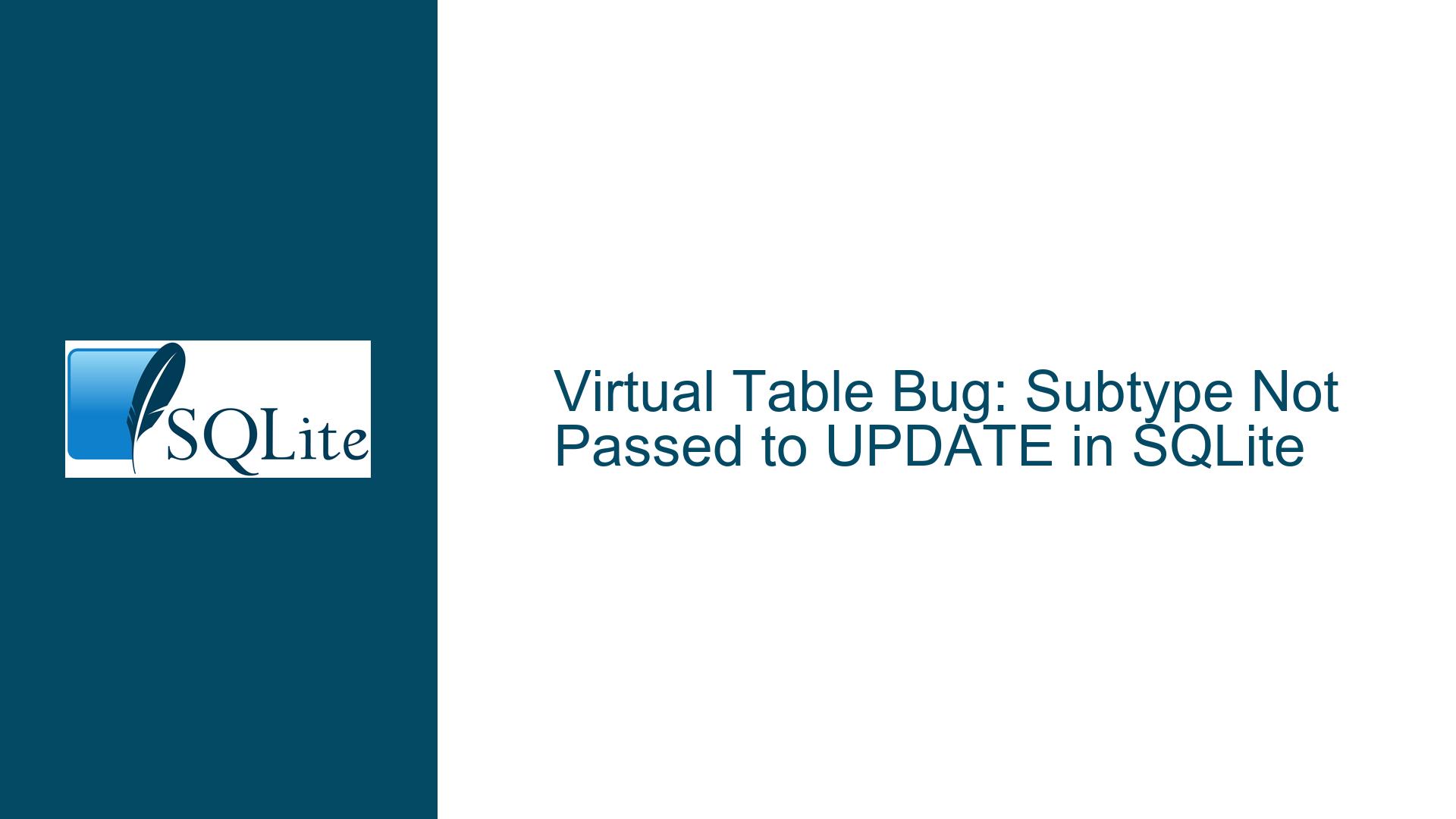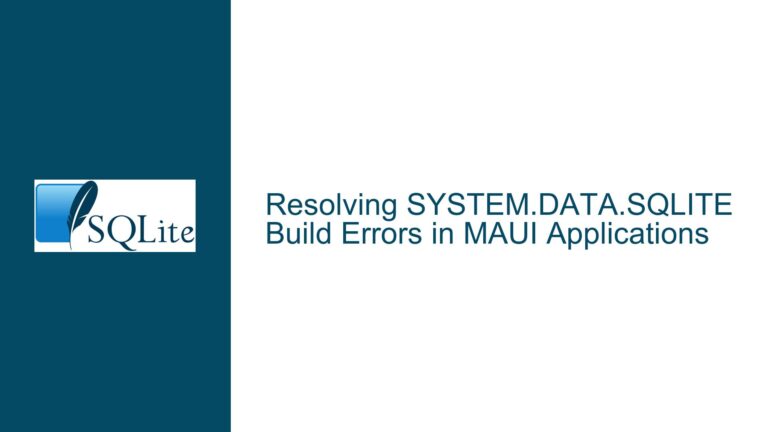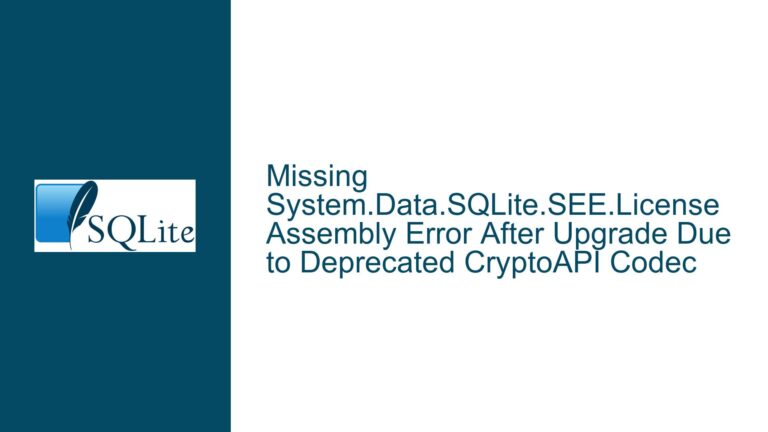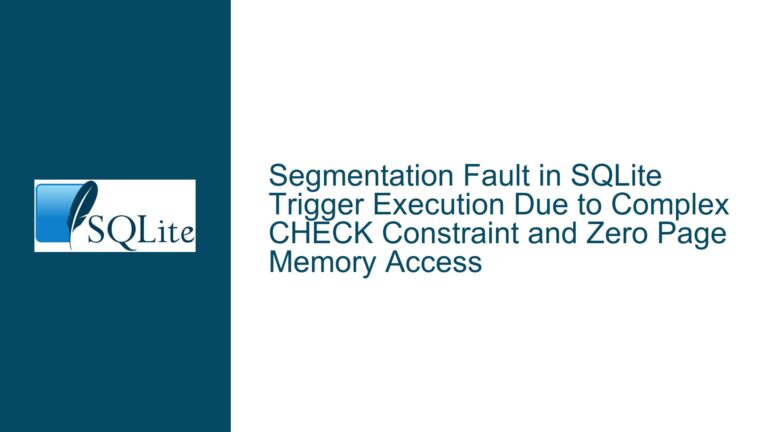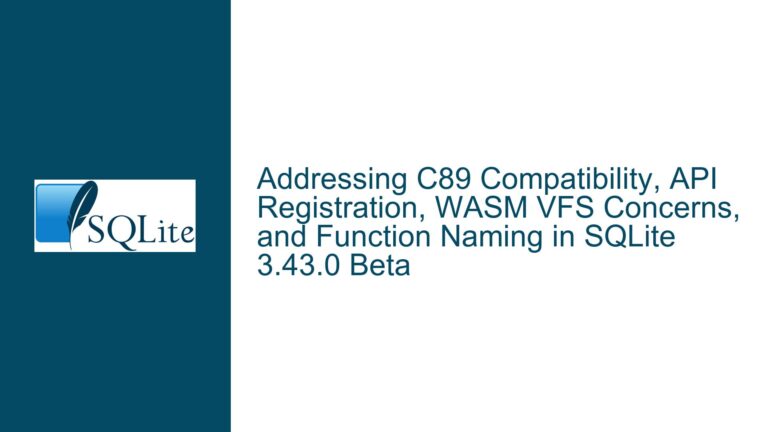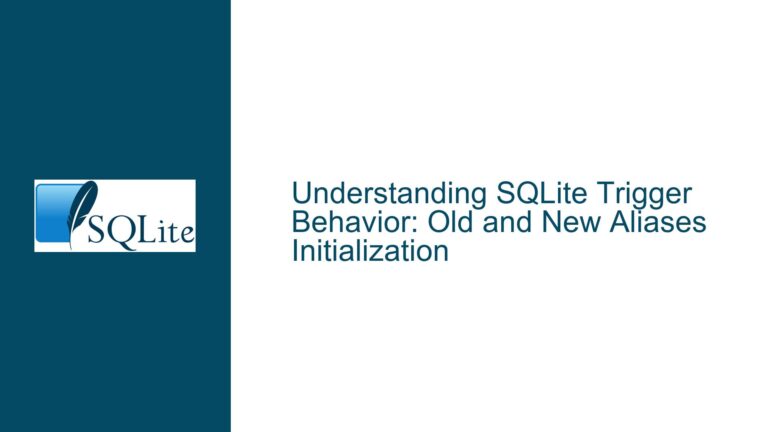Virtual Table Bug: Subtype Not Passed to UPDATE in SQLite
Issue Overview: Subtype Behavior Discrepancy Between INSERT and UPDATE in Virtual Tables
In SQLite, virtual tables provide a powerful mechanism for defining custom table behaviors through a set of callback functions. One such function, xUpdate(), is responsible for handling both INSERT and UPDATE operations. A critical aspect of these operations is the ability to pass and retrieve subtypes associated with column values. Subtypes are metadata that can be attached to SQLite values, allowing developers to extend the type system with additional context or constraints.
The issue at hand involves a discrepancy in how subtypes are handled during INSERT versus UPDATE operations in a virtual table. Specifically, when a value with an associated subtype is inserted into a virtual table, the subtype is correctly passed to the xUpdate() method and can be retrieved using sqlite3_value_subtype(). However, when the same value is used in an UPDATE operation, the subtype is not preserved, and sqlite3_value_subtype() returns 0.
This behavior is particularly problematic for applications that rely on subtypes to enforce type constraints or to distinguish between different kinds of values. For example, in a virtual table designed to handle vector data, subtypes might be used to ensure that inserted vectors match the declared column type. If the subtype is lost during an UPDATE operation, this enforcement mechanism breaks down, potentially leading to data integrity issues.
The issue is further complicated by the use of sqlite3_vtab_nochange(), which allows a virtual table to indicate that a column’s value should not be modified during an UPDATE. Currently, there is no straightforward way to distinguish between a column being set to NULL and a column being marked as unchanged. If subtypes were preserved during UPDATE operations, developers could use a specific subtype value to indicate that a column should remain unchanged, thereby resolving this ambiguity.
Possible Causes: Why Subtypes Are Lost During UPDATE Operations
The root cause of this issue lies in how SQLite handles the propagation of subtypes during different types of operations. When a value is inserted into a virtual table, the subtype is passed along with the value to the xUpdate() method. This allows the virtual table implementation to access the subtype using sqlite3_value_subtype(). However, during an UPDATE operation, the subtype information is not preserved, leading to the observed discrepancy.
One possible explanation for this behavior is that SQLite’s internal handling of UPDATE operations does not include the same subtype propagation logic as INSERT operations. This could be due to an oversight in the implementation of virtual tables, or it could be a deliberate design choice to simplify the handling of UPDATE operations. However, given that subtypes are a documented feature of SQLite and are expected to be available in both INSERT and UPDATE contexts, this behavior is more likely to be a bug.
Another potential cause is the way in which the xUpdate() method is invoked during UPDATE operations. In the case of INSERT, the xUpdate() method is called with a new set of values, including their subtypes. During an UPDATE, however, the method might be called with a different set of parameters, or the subtype information might be stripped out before the method is invoked. This could happen if the SQLite engine does not properly propagate the subtype information from the original value to the updated value.
Additionally, the issue might be related to the specific implementation of the virtual table in question. The debugUpdate() function in the provided code snippet checks the type of the first argument to determine whether the operation is an INSERT or an UPDATE. If the subtype information is not being passed correctly during UPDATE operations, it could be due to a mismatch between the expected and actual parameters in the xUpdate() method.
Troubleshooting Steps, Solutions & Fixes: Addressing the Subtype Discrepancy in Virtual Tables
To address the issue of subtypes not being passed during UPDATE operations in virtual tables, several steps can be taken. These include verifying the behavior with different SQLite versions, examining the virtual table implementation for potential issues, and exploring workarounds or fixes that can be applied to ensure that subtypes are preserved during both INSERT and UPDATE operations.
Step 1: Verify the Behavior Across Different SQLite Versions
The first step in troubleshooting this issue is to verify whether the behavior is consistent across different versions of SQLite. The provided code was tested with SQLite 3.46, but it is possible that the behavior has changed in later versions. By testing the virtual table implementation with different versions of SQLite, it can be determined whether the issue is specific to a particular version or is a more general problem.
To do this, compile the virtual table extension with different versions of SQLite and run the same INSERT and UPDATE operations. If the subtype is preserved during UPDATE operations in some versions but not others, this could indicate that the issue has been fixed in later releases. If the behavior is consistent across all versions, further investigation will be needed.
Step 2: Examine the Virtual Table Implementation
The next step is to carefully examine the virtual table implementation to identify any potential issues that might be causing the subtype discrepancy. In the provided code, the debugUpdate() function is responsible for handling both INSERT and UPDATE operations. This function checks the type of the first argument to determine the type of operation and then prints the subtype of the A column.
One potential issue is that the xUpdate() method might not be receiving the correct parameters during UPDATE operations. The sqlite3_value_subtype() function is used to retrieve the subtype of a value, but if the value itself is not being passed correctly, the subtype information will be lost. To verify this, add additional debugging statements to the debugUpdate() function to print the types and values of all arguments. This will help determine whether the subtype information is being lost before it reaches the xUpdate() method.
Another potential issue is that the virtual table implementation might not be properly handling the sqlite3_vtab_nochange() function. This function is used to indicate that a column’s value should not be modified during an UPDATE. If the subtype information is being lost because of how sqlite3_vtab_nochange() is implemented, this could explain the observed behavior. To test this, modify the virtual table implementation to explicitly handle sqlite3_vtab_nochange() and see if this resolves the issue.
Step 3: Explore Workarounds and Fixes
If the issue is confirmed to be a bug in SQLite’s handling of subtypes during UPDATE operations, there are several potential workarounds and fixes that can be applied. One approach is to modify the virtual table implementation to manually preserve the subtype information during UPDATE operations. This could be done by storing the subtype in a separate column or by using a custom data structure to track the subtype information.
Another approach is to use a different mechanism to enforce type constraints or to distinguish between different kinds of values. For example, instead of relying on subtypes, the virtual table could use a combination of regular columns and custom functions to achieve the same effect. This would require modifying the virtual table implementation and any code that interacts with it, but it would avoid the issue of subtypes being lost during UPDATE operations.
If the issue is determined to be a bug in SQLite itself, the next step would be to report the issue to the SQLite development team. Provide a detailed description of the problem, along with a minimal reproducible example, and request that the issue be addressed in a future release. In the meantime, the workarounds described above can be used to mitigate the impact of the bug.
Step 4: Implement a Custom Subtype Handling Mechanism
If the issue cannot be resolved through the above steps, consider implementing a custom subtype handling mechanism within the virtual table. This could involve extending the virtual table’s data model to include additional metadata columns that store subtype information. For example, add a new column to the virtual table that explicitly stores the subtype for each value. During INSERT and UPDATE operations, manually set this column based on the subtype of the inserted or updated value.
This approach ensures that subtype information is preserved across all operations, regardless of whether it is passed correctly by SQLite. However, it also requires additional storage and may complicate the virtual table’s implementation. Carefully weigh the benefits of this approach against the added complexity before proceeding.
Step 5: Monitor SQLite Updates and Community Feedback
Finally, keep an eye on future SQLite updates and community feedback to see if the issue is addressed in a later release. The SQLite development team is highly responsive to bug reports and community input, and it is possible that the issue will be fixed in a future version. In the meantime, continue to use the workarounds and fixes described above to ensure that the virtual table functions as expected.
By following these steps, the issue of subtypes not being passed during UPDATE operations in virtual tables can be effectively addressed. Whether through careful examination of the virtual table implementation, the use of workarounds, or reporting the issue to the SQLite development team, it is possible to ensure that subtypes are preserved and used correctly in all operations.
